PID算法图形 python
1 2 3 4 5 6 7 8 9 10 11 12 13 14 15 16 17 18 19 20 21 22 23 24 25 26 27 28 29 30 31 32 33 34 35 36 37 38 39 40 41 42 43 44 45 46 47 48 49 50 51 52 53 54 55 56 57 58 59 60 61 62 63 64 65 66 67 68 69 70 71 72 73 74 75 76 77 78 79 80 81 82 83 84 85 86 87 88 89 90 91 92 93 94 95 96 97 98 99 100 101 102 103 104 105 106 107 108 109 110 111 112 113 114 115 116 117 118 119 120 121 122 123 124 125 126 127 128 129 130 131 132 133 134 135 136 137 138 139 | # -*- coding: utf-8 -*-class PID: def __init__(self, P=0.2, I=0.0, D=0.0): self.Kp = P self.Ki = I self.Kd = D self.sample_time = 0.00 self.current_time = time.time() self.last_time = self.current_time self.clear() def clear(self): self.SetPoint = 0.0 self.PTerm = 0.0 self.ITerm = 0.0 self.DTerm = 0.0 self.last_error = 0.0 self.int_error = 0.0 self.windup_guard = 20.0 self.output = 0.0 def update(self, feedback_value): error = self.SetPoint - feedback_value self.current_time = time.time() delta_time = self.current_time - self.last_time delta_error = error - self.last_error if (delta_time >= self.sample_time): self.PTerm = self.Kp * error # 比例 self.ITerm += error * delta_time # 积分 if (self.ITerm < -self.windup_guard): self.ITerm = -self.windup_guard elif (self.ITerm > self.windup_guard): self.ITerm = self.windup_guard self.DTerm = 0.0 if delta_time > 0: self.DTerm = delta_error / delta_time self.last_time = self.current_time self.last_error = error self.output = self.PTerm + (self.Ki * self.ITerm) + (self.Kd * self.DTerm) def setKp(self, proportional_gain): self.Kp = proportional_gain def setKi(self, integral_gain): self.Ki = integral_gain def setKd(self, derivative_gain): self.Kd = derivative_gain def setWindup(self, windup): self.windup_guard = windup def setSampleTime(self, sample_time): self.sample_time = sample_timeimport timeimport matplotlibmatplotlib.use("TkAgg")import matplotlib.pyplot as pltimport numpy as npfrom scipy.interpolate import make_interp_splinedef test_pid(P=0.2, I=0.0, D=0.0, L=100): pid = PID(P, I, D) pid.SetPoint = 0.0 pid.setSampleTime(0.01) END = L feedback = 0 feedback_list = [] time_list = [] setpoint_list = [] for i in range(1, END): pid.update(feedback) output = pid.output # print(output) if pid.SetPoint > 0: feedback += output # (output - (1/i))控制系统的函数 if 9 <= i <= 40: pid.SetPoint = 1 elif i > 40: pid.SetPoint = 0.5 time.sleep(0.01) feedback_list.append(feedback) setpoint_list.append(pid.SetPoint) time_list.append(i) time_sm = np.array(time_list) time_smooth = np.linspace(time_sm.min(), time_sm.max(), 300) feedback_smooth = make_interp_spline(time_list, feedback_list)(time_smooth) plt.figure(0) plt.plot(time_smooth, feedback_smooth) plt.plot(time_list, setpoint_list) plt.xlabel('time (s)') plt.ylabel('PID (PV)') plt.title('TEST PID {}/{}/{}'.format(P, I, D)) plt.xlim((0, L)) plt.ylim((-0.5, 2)) plt.grid(True) # plt.show() plt.savefig('./images/TEST PID {}-{}-{}.jpg'.format(P, I, D)) plt.close()if __name__ == "__main__": test_pid(1.2, 1.0, 0.001, L=50) test_pid(1.2, 1.0, 0, L=50) test_pid(1.2, 0, 0, L=50) test_pid(0.8, 1.0, 0.001, L=50) test_pid(0.8, 1.0, 0, L=50) test_pid(0.8, 0, 0, L=50) test_pid(0.2, 0.0, 0.001, L=50) test_pid(0.2, 0.0, 0, L=50) test_pid(0.2, 0, 0, L=50) test_pid(0.8, 0, 0.001, L=50) test_pid(1.2, 0, 0.001, L=50) test_pid(0.7, 0.8, 0.001, L=50) test_pid(0.8, L=50) |


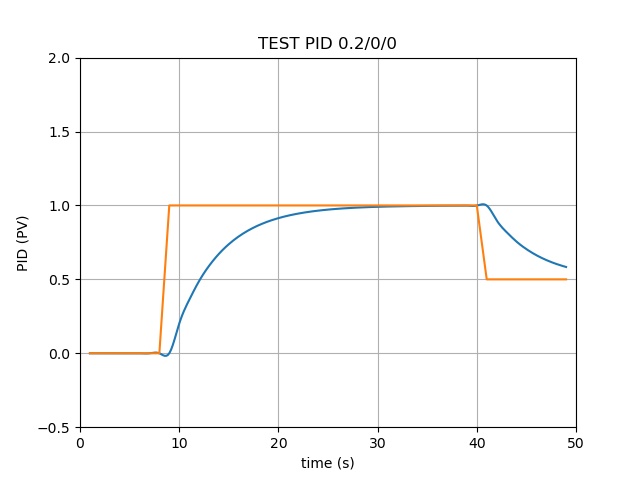

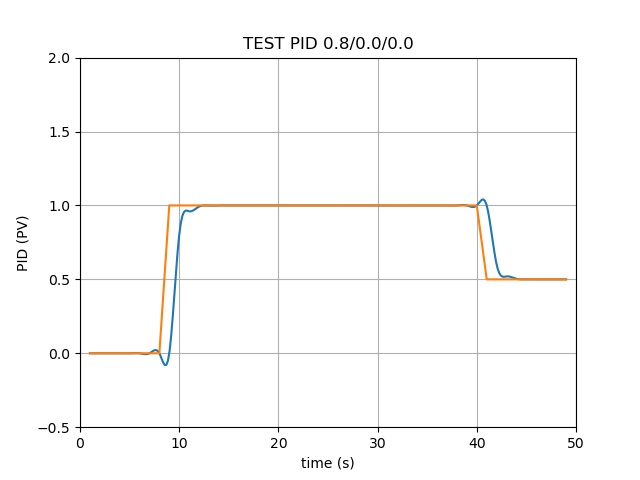
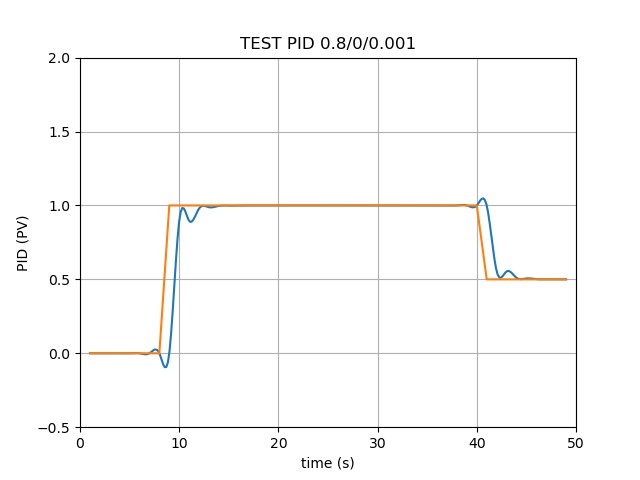
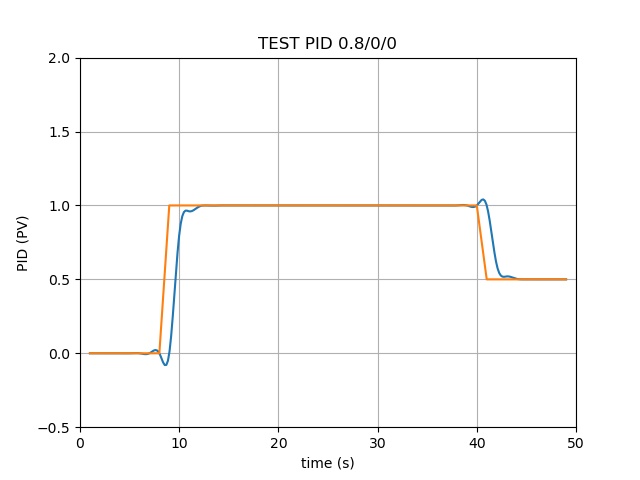
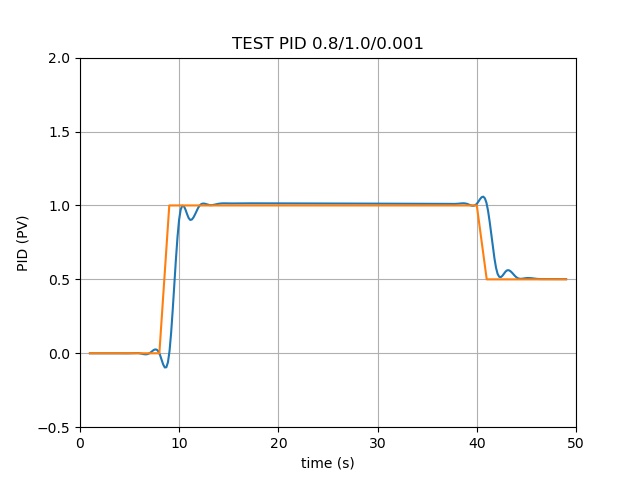
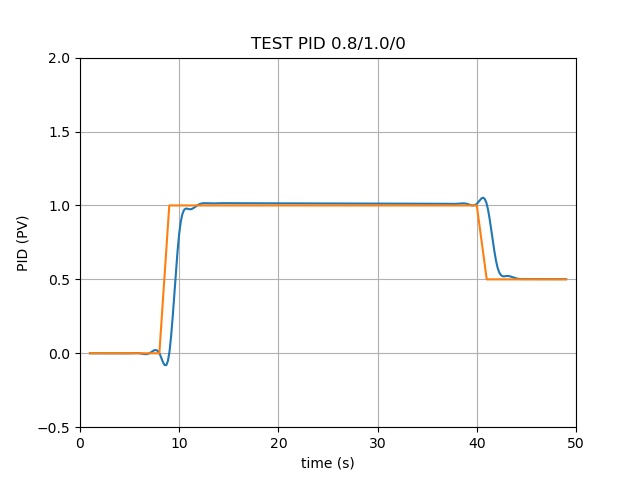
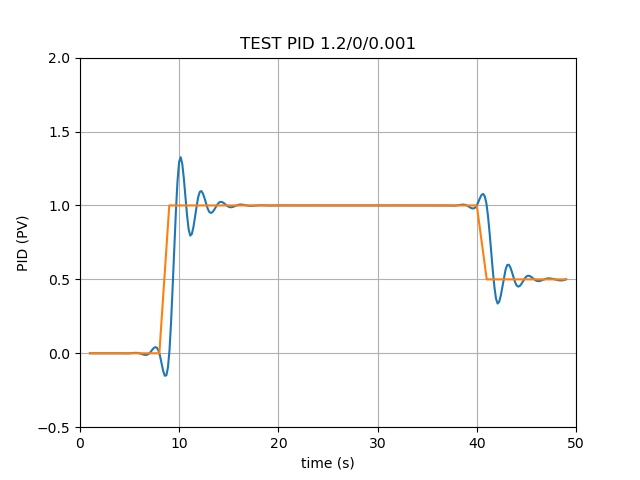



模拟了电动机电压的输出:
- 从0秒开始到第9秒,要求输出电压为0V;
- 从第10秒开始到第40秒,要求输出电压为1V;
- 从第41秒开始到第50秒,要求输出电压为0.5V
橘黄色线代表上述需求(理想输出电压)
绿色线为PID算法输出带反馈积分的输出电压
看得到P(比例)部分 是一个最重要的参数、I(积分)部分能让两条线完全重合(可能过于理想,有待验证)、D(微分)部分会对电压产生微调的上下波动影响
PID算法的参数看来是能够影响元器件寿命的
自省推动进步,视野决定未来。
心怀远大理想。
为了家庭幸福而努力。
商业合作请看此处:https://www.magicube.ai
心怀远大理想。
为了家庭幸福而努力。
商业合作请看此处:https://www.magicube.ai




【推荐】国内首个AI IDE,深度理解中文开发场景,立即下载体验Trae
【推荐】编程新体验,更懂你的AI,立即体验豆包MarsCode编程助手
【推荐】抖音旗下AI助手豆包,你的智能百科全书,全免费不限次数
【推荐】轻量又高性能的 SSH 工具 IShell:AI 加持,快人一步
· 如何编写易于单元测试的代码
· 10年+ .NET Coder 心语,封装的思维:从隐藏、稳定开始理解其本质意义
· .NET Core 中如何实现缓存的预热?
· 从 HTTP 原因短语缺失研究 HTTP/2 和 HTTP/3 的设计差异
· AI与.NET技术实操系列:向量存储与相似性搜索在 .NET 中的实现
· 地球OL攻略 —— 某应届生求职总结
· 周边上新:园子的第一款马克杯温暖上架
· Open-Sora 2.0 重磅开源!
· 提示词工程——AI应用必不可少的技术
· .NET周刊【3月第1期 2025-03-02】